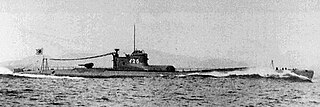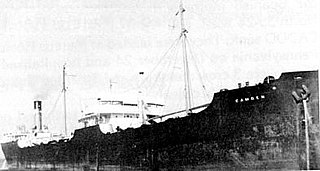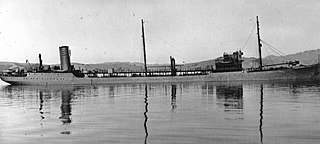
USS Grayback (SS-208), a Tambor-class submarine, was the first ship of the United States Navy to be named for the lake herring, Coregonus artedi. She ranked 20th among all U.S. submarines in total tonnage sunk during World War II, with 63,835 tons, and 24th in number of ships sunk, with 14. She was sunk near Okinawa on 27 February 1944. Her wreck was discovered in June 2019.
I-25 (イ-25) was a B1 type (I-15-class) submarine of the Imperial Japanese Navy that served in World War II, took part in the Attack on Pearl Harbor, and was the only Axis submarine to carry out aerial bombing on the continental United States in World War II, during the so-called Lookout Air Raids, and the shelling of Fort Stevens, both attacks occurring in the state of Oregon.

SS Absaroka was a steamer, named after the Absaroka Range of mountains in Montana and Wyoming, completed in February 1918 for the United States Shipping Board (USSB) which briefly operated the ship. From 17 September 1918 to 4 March 1919 the ship was commissioned as USS Absaroka with the identification number IX-2581 in United States Navy and operated by the Naval Overseas Transportation Service.

Hammac was a steam tank ship built in 1920–1921 by Bethlehem Shipbuilding Corporation of Alameda for the United States Shipping Board as part of the wartime shipbuilding program of the Emergency Fleet Corporation (EFC) to restore the nation's Merchant Marine. Early in 1923 the vessel together with two other tankers was sold to General Petroleum Corporation and renamed Emidio. The tanker spent the vast majority of her career carrying oil along the West Coast of the United States as well as between West and East coast. In December 1941 she was shelled and damaged by the Japanese submarine I-17 and eventually wrecked with a loss of five crewmen.

I-26 was an Imperial Japanese Navy B1 type submarine commissioned in 1941. She saw service in the Pacific War theatre of World War II, patrolling off the West Coast of Canada and the United States, the east coast of Australia, and Fiji and in the Indian Ocean and taking part in Operation K, preparatory operations for the Aleutian Islands campaign, and the Guadalcanal campaign, the Marianas campaign, and the Battle of Leyte Gulf. She was the first Japanese submarine to sink an American merchant ship in the war, sank the first ship lost off the coast of State of Washington during the war, damaged the aircraft carrier USS Saratoga (CV-3), sank the light cruiser USS Juneau (CLAA-52), and was the third-highest-scoring Japanese submarine of World War II in terms of shipping tonnage sunk. Her bombardment of Vancouver Island in 1942 was the first foreign attack on Canadian soil since 1870. In 1944, I-26′s crew committed war crimes in attacking the survivors of a ship she sank. She was sunk in November 1944 during her ninth war patrol.

The Battle of Los Angeles, also known as the Great Los Angeles Air Raid, is the name given by contemporary sources to a rumored attack on the continental United States by Imperial Japan and the subsequent anti-aircraft artillery barrage which took place from late 24 February to early 25 February 1942, over Los Angeles, California. The incident occurred less than three months after the U.S. entered World War II in response to the Imperial Japanese Navy's surprise attack on Pearl Harbor, and one day after the bombardment of Ellwood near Santa Barbara on 23 February. Initially, the target of the aerial barrage was thought to be an attacking force from Japan, but speaking at a press conference shortly afterward, Secretary of the Navy Frank Knox called the purported attack a "false alarm". Newspapers of the time published a number of reports and speculations of a cover-up to conceal an actual invasion by enemy airplanes.
I-21 was a Japanese Type B1 submarine which saw service during World War II in the Imperial Japanese Navy. She displaced 1,950 tons and had a speed of 24 knots (44 km/h). I-21 was the most successful Japanese submarine to operate in Australian waters, participating in the attack on Sydney Harbour in 1942 and sinking 44,000 tons of Allied shipping during her two deployments off the east coast of Australia.
I-17 was a Japanese B1 type submarine of the Imperial Japanese Navy which saw service during World War II. This long-range submarine cruiser spent the early months of the war in the eastern Pacific and was the first Axis ship to shell the continental United States. She later supported the Imperial Japanese Army in fighting around the Solomon Islands and remained active in the southwest Pacific until she was sunk in August 1943.

The Bombardment of Ellwood during World War II was a naval attack by a Japanese submarine against United States coastal targets near Santa Barbara, California. Though the damage was minimal, the event was key in triggering the West Coast invasion scare and influenced the decision to intern Japanese-Americans. The event also marked the first shelling of the North American mainland during the conflict.
I-23 was a Type B1 submarine of the Imperial Japanese Navy during World War II. After a raid on the West Coast of California she participated in an attempt at a second attack upon Pearl Harbor. After surviving an American air attack on Kwajalein I-23 was lost in early 1942 with all hands somewhere off the Oahu coast of Hawaii.

SS Logan Victory was a cargo Victory ship built for World War II under the Emergency Shipbuilding program. The Logan Victory was launched January 16, 1945, by Permanente Metals Corporation, Richmond, California and completed on February 6, 1945. She was operated by the American-Hawaiian Steamship Company under the United States Maritime Commission.

California during World War II was a major contributor to the World War II effort. California's long Pacific Ocean coastline provided the support needed for the Pacific War. California also supported the war in Europe. After the Japanese attack on Pearl Harbor on December 7, 1941, most of California's manufacturing was shifted to the war effort. California became a major ship builder and aircraft manufacturer. Existing military installations were enlarged and many new ones were built. California trained many of the troops before their oversea deployment. Over 800,000 Californians served in the United States Armed Forces. California agriculture, ranches and farms were used to feed the troops around the world. California's long coastline also put the state in fear, as an attack on California seemed likely. California was used for the temporary and permanent internment camps for Japanese Americans. The population grew significantly, largely due to servicemen who were stationed at the new military bases/training facilities and the mass influx of workers from around the U.S. in the growing defense industries. With all the new economy activity, California was lifted out of the Great Depression. Over 500,000 people moved to California from other states to work in the growing economy. California expanded its oil and mineral production to keep up with the war demand.

Larry Doheny was a tanker ship that sank during World War II, after an attack by Japanese submarine I-25 on October 5, 1942, at 10:00pm. Larry Doheny sank with six of her crew killed off the coast of Cape Sebastian, off the southern coast of Oregon. Larry Doheny was on her way to Portland, Oregon loaded with 66,000 barrels of fuel oil from Long Beach, California. The torpedo attack caused the #2 and #3 storage tanks to explode. The explosion took out the radio, so no distress call was sent. The surviving 40 crew members were rescued by USS Coos Bay, a United States Navy Barnegat-class small seaplane tender, the next day. The ship was not salvaged. SS Emidio and SS Montebello were also attacked and sank off the West Coast of the United States. SS Larry Doheny was built by Sun Shipbuilding & Drydock Company. She had nine cargo tanks, her homeport was Los Angeles.
SS Dorothy Phillips was a 2,119-ton cargo ship that was attacked during World War II. The Japanese submarine I-23 fired at her on December 24, 1941. Dorothy Phillips was damaged in the attack off the coast of Monterey, California. In the attack the ship's rudder was damaged and the ship could not steer and ran aground. Dorothy Phillips was built in 1918 by Albina Engine and Machine Works in Portland, Oregon. The attack helped put fear into the west coast and started the Battle of Los Angeles. SS Emidio and SS Larry Doheny were also attacked and sank off the West Coast of the United States. Dorothy Phillips was built by Albina Engine & Machine Works in a shipyard along the Willamette River in Portland, Oregon, United States. Dorothy Phillips was produced as a freighters for World War I as Point Loma. In 1937 she was sold and renamed Dorothy Phillips. In 1946 she was sold and renamed Karen Olson. In 1957 she was sold and renamed Rio Tigre. In 1962 she was scrapped.

SS Camden was an American 6,653-ton tanker built by the New York Shipbuilding Company of Camden, New Jersey, for the Charles Kurz & Co. Inc. of Pennsylvania Shipping Company. She was operated by Shell Oil Company of Wilmington, Delaware. She was launched in 1921. The ship became famous when it was torpedoed early in World War II off the West Coast of the United States off Coos Bay, Oregon, at 43.38 N, –124.48 W at 7:00 am. She had departed San Pedro, Los Angeles, California, to Portland, Oregon, with fuel oil. The ship was attacked by Japanese submarine I-25 on October 4, 1942 off Oregon. She had been stopped for engine repairs at the time of the attack. She survived the attack, but later sank on October 10. One Crew member died and went down with the ship. The Camden was set on fire by the torpedo hit to her bow and was sinking. The crew abandoned ship and was rescued by a Swedish merchant ship, the MV Kookaburra. The Camden still on fire remained afloat. The tugboat Kenai was towing her to Astoria, Oregon, but then changed the path to Seattle, but the Camden sank off the coast of Washington state at 46.7772, -124.5208 and now rests at a depth of 312 feet.

SS Connecticut was a 8684 ton tanker ship built in 1938 by Bethlehem Shipbuilding Corporation and used for a World War II. She operated her under the United States Merchant Marine act for the War Shipping Administration, with United States Navy Armed Guards to man her deck guns. On December 28, 1941, the Connecticut was torpedoed near Cape Disappointment in the Pacific Ocean by I-25 of the Imperial Japanese Navy. To stop from sinking the Connecticut ran aground and was later salvaged. The attack took place 10 nautical miles off the mouth of the Columbia River near Oregon. The Japanese attack on the Connecticut was under the command of Lieutenant Commander Akiji Tagami.

H.M. Storey was an oil tanker built in 1921. She escaped an attack in California in 1941, but was sunk in an attack in 1943. She was owned by Standard Oil Company of California and built by Bethlehem Shipbuilding Corporation at the Alameda Works Shipyard with a hull# of 5312. She had a max. capacity of 306,115 gallons of fuel oil. Her keel was laid on January 19, 1921 and she was launched on September 28, 1921. Her sister ships are the SS F.H. Hillman and SS W.S. Rheem. She had a range of 7,717 miles, 10,763 DWT and a 16,000 ton displacement. She had a length of 500 feet, a beam of 68.2 feet and a draft of 30 feet. She had 2,700 hp, made by a triple-expansion engine with dual shaft and 2 screws. She had three Scotch boilers. Named for Henry Martin Storey, vice president of the Standard Oil Company.

SS Cynthia Olson was a cargo ship originally built in Wisconsin in 1918 as the SS Coquina. Renamed in 1940, in August 1941 she was chartered by the US Army to transport supplies to Hawaii. While in passage between Tacoma, Washington and Honolulu on December 7, she was intercepted by the Japanese submarine I-26, which sank her with gunfire. Although the commander of the submarine ensured that all of the crew had escaped into boats, none of them were ever found. Cynthia Olson was the first United States Merchant Marine vessel to be sunk after the entry of the United States into World War II.

The SS Samoa was a 1,997-ton cargo ship that was able to escape an attack off the coast of California in the early days of World War II. The Samoa was built under a United States Shipping Board (USSB) contract in 1918 as the SS Muerthe, but was launched as the USS Lake Pepin, named after Lake Pepin, by the McDougall Duluth Shipbuilding Company of Duluth, Minnesota measured at 3,600 tons deadweight. She had a triple expansion engine steam engine with 1,250 horsepower (930 kW), a 251-foot (77 m) length, 43.5-foot (13.3 m) beam, a draft of 17 feet 8+1⁄2 inches (5.398 m), a top speed of 9.25 knots. The vessel had a crew of 52, with the hull # 9 and O.N.ID # 21699. The USS Lake Pepin was owned and operated by the United States Navy, commissioned at Montreal, Quebec, Canada on 4 September 1918. For World War I she was fitted with one 3"/50 caliber gun. The Navy put her in Naval Overseas Transportation Service as a coal carrier traveling between the United Kingdom and France as a United States Navy Temporary auxiliary ship. Her coal service ended in May 1919. In June 1919 she returned to the US with a cargo of World War I vehicles and weapons and unused ammunition. The US Navy decommissioned the Lake Pepin on 18 June 1919. In 1923 she was, renamed Samoa purchased and operated by the Hammond Lumber Company. In 1936 she was sold to the Wheeler Logging Company of Portland, Oregon. In February of 1941 she was sold to W. A. Schaefer Company.

SS Barbara Olson was a cargo ship built in Wisconsin in 1918 as the SS Corrales. Barbara Olson was able to escape an attack off the coast of California in the early days of World War II. The Barbara Olson was built under a United States Shipping Board (USSB) contract in 1918 as the SS Corrales and renamed in 1940. On July 25, 1942, she was chartered by the US Army to transport supplies to the Territory of Hawaii as the USAT Barbara Olson for World War II. On January 14, 1946, her Army service ended. In 1964 she was run aground four miles (6.4 km) north of Pimentel, Peru and declared a total loss.
















